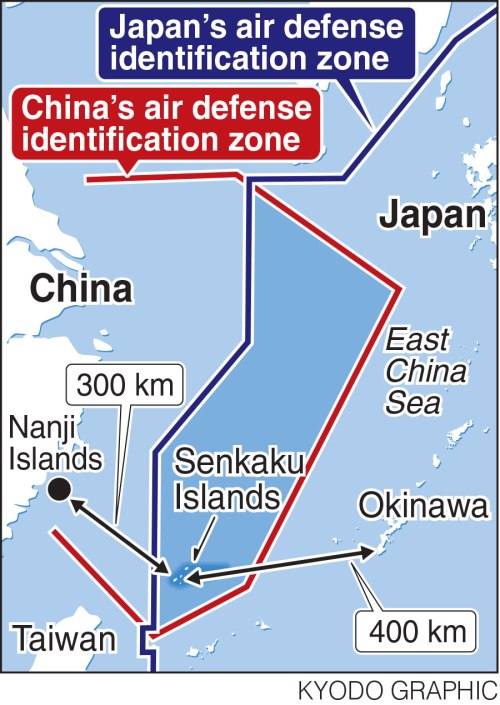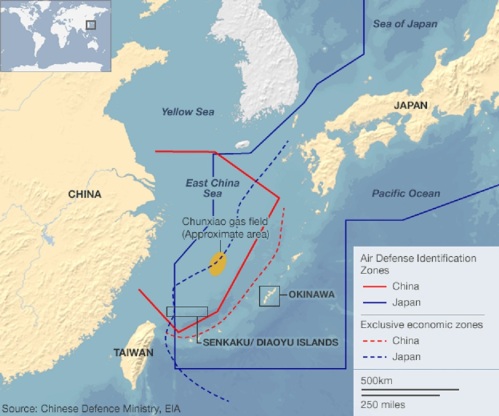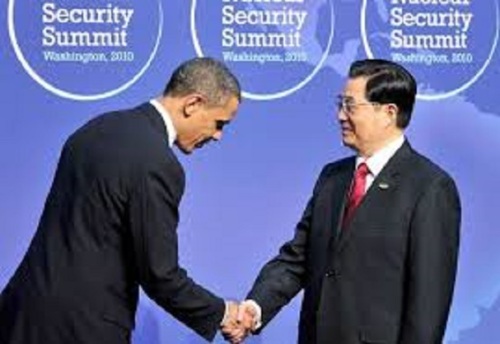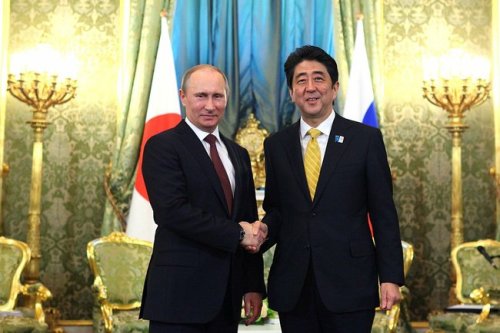At the end of the Ryukyu archipelago in the East China Sea is a cluster of small islands called Senkaku by the Japanese and Diaoyutai by the Chinese, the ownership of which is contested by Beijing and Tokyo. The waters surrounding the islets are believed to contain sub-soil oil and natural gas deposits.
On November 24, 2013, China made a bold move toward its claim by declaring an East China Sea Air Defense Identification Zone (ADIZ) that includes the air space over the contested islands.
At first, the United States appeared to challenge China’s ADIZ by flying B-52 bombers over the area. Two days later, China demonstrated its resolve by sending warplanes into the ADIZ. The Obama administration then backed off, told U.S. commercial airlines to abide by China’s rules in the ADIZ, then seemed to signal that the U.S. would accept China’s ADIZ in the East China Sea although the U.S. official position is that it does not recognize the Chinese air defense zone as it covers large areas of international airspace and waters.
Now China has made another move to reclaim the islands.
Bill Gertz reports for The Washington Free Beacon, Jan. 27, 2015, that recent satellite photos of an island off the coast of China confirm Beijing’s buildup of military forces within attack range of the Senkaku islands.
In October 2014, construction of a helicopter base on Nanji Island was observed by a commercial spy satellite. The island is off the coast of China’s Zhejiang province—some 186 miles northwest of the Senkakus. The imagery, obtained from the Airbus Defense and Space-owned Pleaides satellite, reveals China is constructing an airfield with 10 landing pads for helicopters on Nanji Island.
Click images below to enlarge

 Military analysts say the new military base on Nanji Island appears to be preparation by the Chinese People’s Liberation Army for an attack or seizure of the Senkakus. Rick Fisher, a senior fellow with the International Assessment and Strategy Center, said:
Military analysts say the new military base on Nanji Island appears to be preparation by the Chinese People’s Liberation Army for an attack or seizure of the Senkakus. Rick Fisher, a senior fellow with the International Assessment and Strategy Center, said:
“China’s new heli-base on Nanji Island demonstrates that the PLA is preparing for an offensive military operation against the Senkaku/Daiyoutai Islands. If you want to rate the level of tension, this is the PLA reaching for its holster. When forces start deploying to Nanji Island, that means the hammer is cocked.”
The military buildup on Nanji was first disclosed by Japan’s Kyodo News Service last month. Kyodo, quoting Chinese sources, said a landing strip was being built. However, the satellite photos, reported last week by IHS trade publication Jane’s Defence Weekly, did not indicate construction of an airstrip, only helicopter landing pads. The helicopter base construction is new because photos taken earlier than October 2013 do not show any visible construction. In addition to the helicopter pads, wind turbines on a ridge on the southeast part of Nanji also are visible additions to the island. Radar and communications equipment also is visible. The helicopter pads are an indication that China plans to use the base for transporting troops and forces by helicopter and not for longer-range air transports or fighter jets.
China has been engaged in a tense confrontation with Japan over the Senkakus since 2012, when Tokyo, in a bid to clarify the status of the uninhabited islands, purchased three of the islands from private owners in a bid to prevent Tokyo Gov. Shintaro Ishihara from buying them. Since then, Chinese ships and warplanes, as well as unmanned surveillance drones, have been flying close to the islands, prompting numerous Japanese maritime and aerial intercepts.
China’s Defense Ministry did not dispute the military buildup on Nanji.
On Dec. 25, 2014, at the same time as he called Japanese news reports of the construction on Nanji “irresponsible,” Chinese Defense Ministry spokesman PLA Sr. Col. Yang Yujun told reporters in Beijing that “There is no doubt that China has the right to conduct activities and construction on its own territory. Some media in Japan make irresponsible speculations on China’s legitimate activities and construction and play up tensions in the region. It is pure media hype.”
Questions were raised during the discussion with Yang as to whether the buildup is part of China’s declaration of an air defense identification zone over the East China Sea that covers the Senkakus.
Retired PLA Maj. Gen. Xu Guangyu, a senior adviser at China Arms Control and Disarmament Association, a Beijing-based research group, told Singapore’s Today newspaper on Dec. 23, that the Nanji military construction was “normal” and that “China has military bases in several strategically important coastal islands and the Nanji is one of them. The Japanese media is only singling out the Nanji and making a big fuss, [and] this can be misleading.”
Jane’s said the Nanji construction appears to be part of a “quiet military buildup around the Senkaku/Daioyu islands by both sides. For its part, Japan is putting aside funds to buy land for a coastal surveillance radar unit on Yonaguni island, which is the westernmost of its islands and only 150 kilometers from the Senkaku/Diaoyu islands, while it is also training up and kitting out a small marine corps-style force that will be based in Nagasaki.”
The lack of an airfield is a “gap” in Chinese plans for military operations against the Senkakus, Jane’s said. The closest PLA air base to the Senkakus currently is located at Luqiao, some 236 miles from the Senkakus, where J-10 fighters are based.
Fisher, however, said Nanji could be used by the PLA to base its large Zubr air-cushioned hovercraft that are capable of moving troops and tanks in a takeover of the Senkakus or an assault against Taiwan.
A Japanese Embassy spokesman declined to comment on the Chinese military construction: “We are in the process of gathering information on this, and thus not able to comment.” A Pentagon spokesman did not respond to an email request for comment.
Note: The United States has a mutual defense treaty with Japan, and a Congressional act with the Republic of China on Taiwan called the Taiwan Relations Act (1979), wherein the U.S. states it is committed to the maintenance of peace and security in the Western Pacific (which includes the Taiwan Strait).
See also:
- Dir. of U.S. Navy Intelligence sacked for warning about China’s aggressive plans in East China Sea
- China’s irredentist nationalism and the six wars to come
- China’s new map includes ‘Second National Territory’ of oceans
- South Korea reacts to China’s Air Defense Identification Zone by expanding its ADIZ
- PLA officer says China must establish Air Defense Identification Zone in South China Sea
- China stakes claim to South China Sea by building islands in the Spratlys
~StMA















